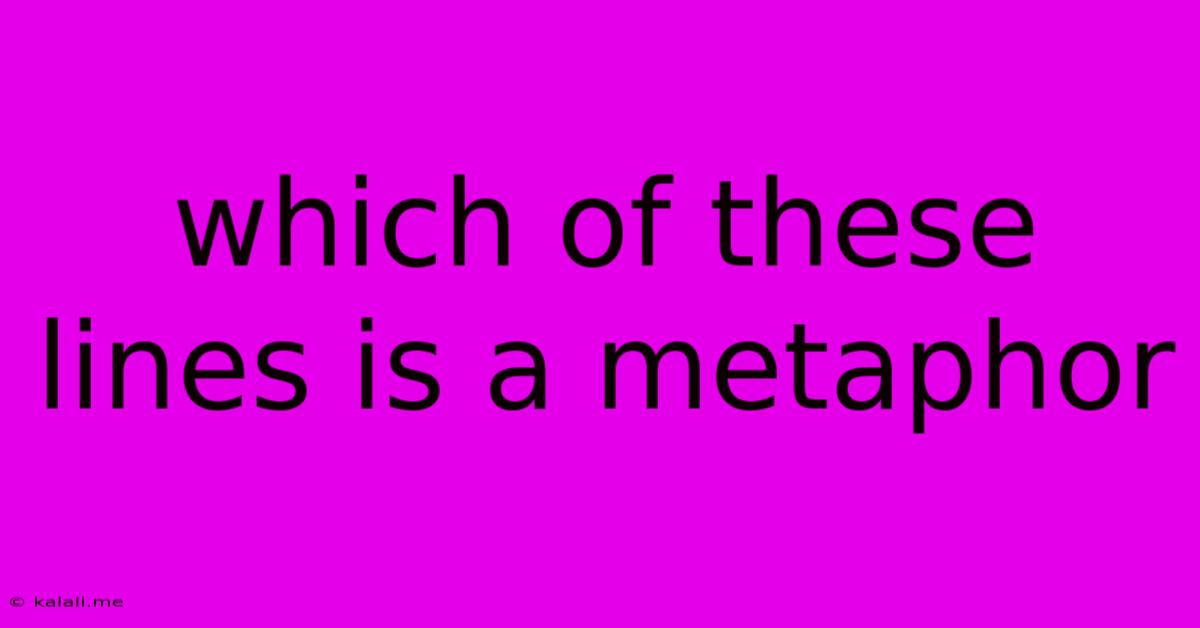Which Of These Lines Is A Metaphor
Kalali
Jun 14, 2025 · 3 min read

Table of Contents
Which of These Lines is a Metaphor? Understanding Figurative Language
Metaphors are a powerful tool in writing, adding depth and color to our descriptions. But what exactly is a metaphor, and how can you distinguish it from other figures of speech? This article will explore the definition of a metaphor and help you identify them, even in complex sentences. We'll examine several examples to clarify the concept and equip you to confidently analyze literary texts.
What is a Metaphor?
A metaphor is a figure of speech that directly compares two unrelated things without using words like "like" or "as." It asserts that one thing is another, creating a vivid image in the reader's mind. The comparison is implied, not explicitly stated. This direct comparison helps convey meaning beyond the literal. Think of it as a shortcut to understanding a complex idea or feeling.
Examples to Illustrate:
Let's consider some examples to understand the difference between a metaphor and other figures of speech, such as similes and analogies. We will examine the following lines:
- "The snow is a white blanket covering the ground."
- "Her laughter was like music to his ears."
- "He is a lion in battle."
- "Time is a river, constantly flowing."
- "The assignment was a mountain to climb."
Identifying the Metaphors:
-
Line 1: This is a simile, not a metaphor. The word "is" is used, but it's followed by "a," indicating a comparison using "like" or "as" implicitly.
-
Line 2: This is also a simile. The comparison uses the word "like," explicitly stating the resemblance.
-
Line 3: This is a metaphor. It directly states that "he is a lion," comparing his behavior in battle to the characteristics of a lion (strength, ferocity). There's no explicit comparison word.
-
Line 4: This is a metaphor. It directly equates time to a river, highlighting the continuous and unstoppable flow of both.
-
Line 5: This is a metaphor. The difficulty of the assignment is compared to the challenging task of climbing a mountain.
Key Differences: Metaphor vs. Simile vs. Analogy
To further solidify your understanding, let's summarize the key differences:
- Metaphor: A direct comparison stating one thing is another. No comparison words are used.
- Simile: An indirect comparison using words like "like" or "as."
- Analogy: A comparison between two things to explain or clarify an idea. Analogies can use metaphors or similes, but they're broader in scope and often more extended.
Conclusion:
Understanding the nuances of figurative language, especially metaphors, is crucial for both writers and readers. By recognizing the direct and implied comparisons in metaphors, you can better appreciate the richness and depth of literary expression. Identifying these figures of speech enhances comprehension and allows you to analyze the author's intentions and the overall impact of the text. Remember to look for implicit comparisons where one thing is directly equated to another, without the use of "like" or "as," to correctly identify a metaphor.
Latest Posts
Latest Posts
-
If A Waves Frequency Doubles Its Wavelength
Jun 14, 2025
-
New Mexico State University Admission Requirements
Jun 14, 2025
-
What Is Not Required For Photosynthesis
Jun 14, 2025
-
Days To Celebrate In April 2024
Jun 14, 2025
-
What Is Not Found In A Animal Cell
Jun 14, 2025
Related Post
Thank you for visiting our website which covers about Which Of These Lines Is A Metaphor . We hope the information provided has been useful to you. Feel free to contact us if you have any questions or need further assistance. See you next time and don't miss to bookmark.